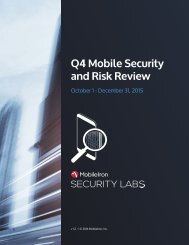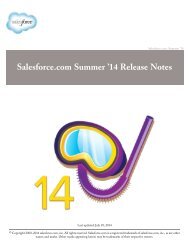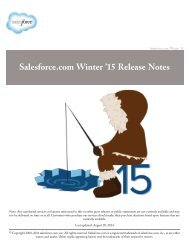salesforce_security_impl_guide
salesforce_security_impl_guide
salesforce_security_impl_guide
Create successful ePaper yourself
Turn your PDF publications into a flip-book with our unique Google optimized e-Paper software.
Securing and Sharing Data<br />
User Sharing Overview<br />
• Click the Recalculate button for the sharing rules on the Sharing Settings page<br />
• Recalculate your sharing rules on the Defer sharing page<br />
You can monitor the progress of your parallel recalculation on the Background Jobs page or view your recent sharing operations on the<br />
View Setup Audit Trail page.<br />
Recalculation of sharing rules maintains <strong>impl</strong>icit sharing between accounts and child records. In the Background Jobs page, these<br />
processes corresponds to these job sub types:, Account — Extra Parent Access Removal and Account — Parent Access Grant.<br />
Additionally, deleting a sharing rule corresponds to the job sub type Object — Access Cleanup, denoting that irrelevant share rows<br />
are removed.<br />
Note: For an in-depth look at record access, see Designing Record Access for Enterprise Scale.<br />
User Sharing Overview<br />
Control who sees who in the organization with standard sharing functionality.<br />
EDITIONS<br />
Watch a demo: Who Sees Whom: User Sharing<br />
Available in:<br />
Watch how you can set up User Sharing in your organization.<br />
• Enterprise<br />
• Performance<br />
User Sharing enables you to show or hide an internal or external user from another user in your<br />
• Unlimited<br />
organization. For example, you might be a manufacturer who needs to include all dealers in your<br />
• Developer<br />
organization while still keeping them from seeing or interacting with each other. You can set the<br />
organization-wide defaults for the user object to Private. Then, open up access among groups of<br />
dealers who need to see and interact with each other in the organization with sharing rules or manual sharing.<br />
With User Sharing, you can:<br />
• Assign the “View All Users” permission to users who need to see or interact with all users. This permission is automatically enabled<br />
for users who have the “Manage Users” permission.<br />
• Set the organization-wide default for user records to Private or Public Read Only.<br />
• Create user sharing rules based on group membership or other criteria.<br />
• Create manual shares for user records to open up access to individual users or groups.<br />
• Control the visibility of external users in customer or partner portals and communities.<br />
See the Understanding User Sharing tip sheet for more information.<br />
Understanding User Sharing<br />
Set organization-wide defaults for internal and external user records. Then, extend access using<br />
sharing rules based on membership to public groups, roles, or territories, or use manual sharing to<br />
share individual user records with other users or groups.<br />
When you enable user sharing, users can see other users in search, list views, and so on only if they<br />
have Read access on those users.<br />
Review these considerations before you <strong>impl</strong>ement user sharing.<br />
“View All Users” permission<br />
This permission can be assigned to users who need Read access to all users, regardless of the<br />
sharing settings. If you already have the “Manage Users” permission, you are automatically<br />
granted the “View All Users” permission.<br />
EDITIONS<br />
Available in:<br />
• Professional<br />
• Enterprise<br />
• Performance<br />
• Unlimited<br />
• Developer<br />
69






